may Google puke with FCS networker
If SEO were an Olympic sport, it would be race walking.
Everyone is after that first place slot – but it’s a long, slow, and strategic path to getting there.
By now, just about every marketer knows the basics of how to rank.
Find and target the right keywords.
Create high-quality content that your audience is looking for.
Prove time and time again that Google should value your content – and that it’s worth showing off to their users.
It’s a tedious and time-consuming process.
And if you do happen to make it to the top slot, it can be snatched away by a competitor at any moment.
Do you ever wish there was a shortcut that would allow you to breeze right past the competition and secure your slot at the front of the pack?
There is an underutilized market that might allow you to leapfrog your competition in a ranking list.
Featured snippets.
Featured snippets can act like your race track to first place.
By targeting this up-and-coming feature, snippets can help you rank highly in less time.
What are featured snippets?
When searching on Google, have you ever noticed the text boxes that jump out and answer your question before you ever even make it to a website?
Well, that is a featured snippet.
These descriptive boxes flip the traditional Google search result listing around.
Rather than giving you the headline, URL, and website first, you get the information, otherwise known as the “snippet.”
Featured snippets can come in many different forms.
First, we have the paragraph featured snippet.
Do a quick Google search of “why is the sky blue,” and you’ll be met with this result:
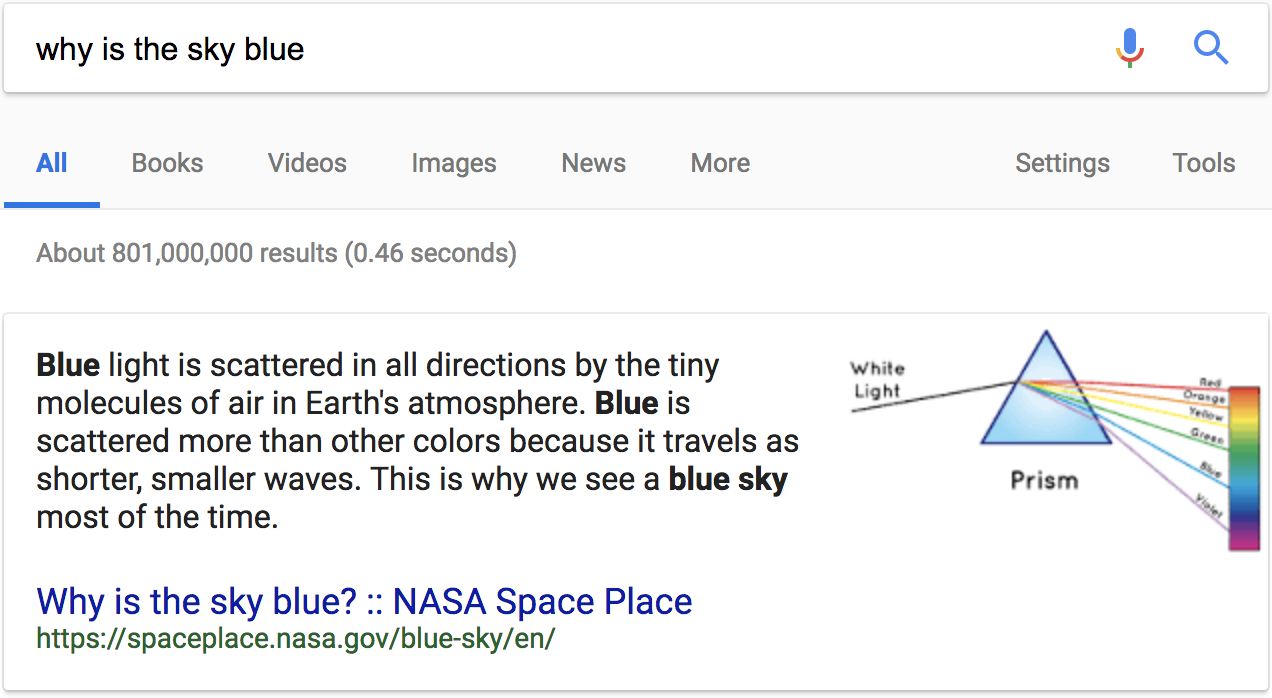
This box breaks down exactly what makes the sky blue is an example of a featured paragraph snippet.
The paragraph featured snippet is the most basic of all the snippet forms.
However, it’s the standard response to questions like “who is…” and “why is…”
For “how to” questions, you’re likely to get a list featured snippet.
Let’s say you clogged your drain and you’re looking for some help before calling the plumber.
You jump on to Google and search “how to unclog a drain.”
These are probably the results you’ll get…

Like the paragraph featured snippet, a list featured snippet provides the details first.
While less common, how to questions may also bring up a new kind of featured snippet – a video.
Let’s do a quick search for “how to braid hair.”
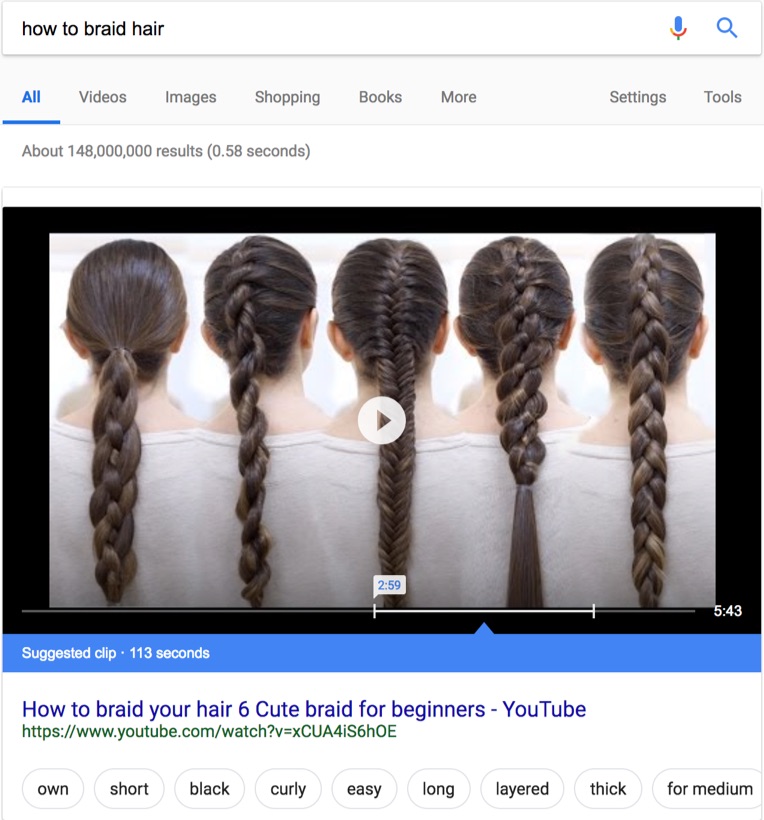
The featured snippet you’re given is taken straight from YouTube. You can watch the content right on the results page.
You’ll also notice that the snippet offers additional options to make your search more specific.
These are known as refinement bubbles.
Refinement bubbles help to narrow down your search without needing to start the search over.
Another popular type of featured snippet is the table.
You’re most likely to see a table featured snippet after searching for comparisons or statistics.
Here is the result when you search “biggest growth industries” in Google.
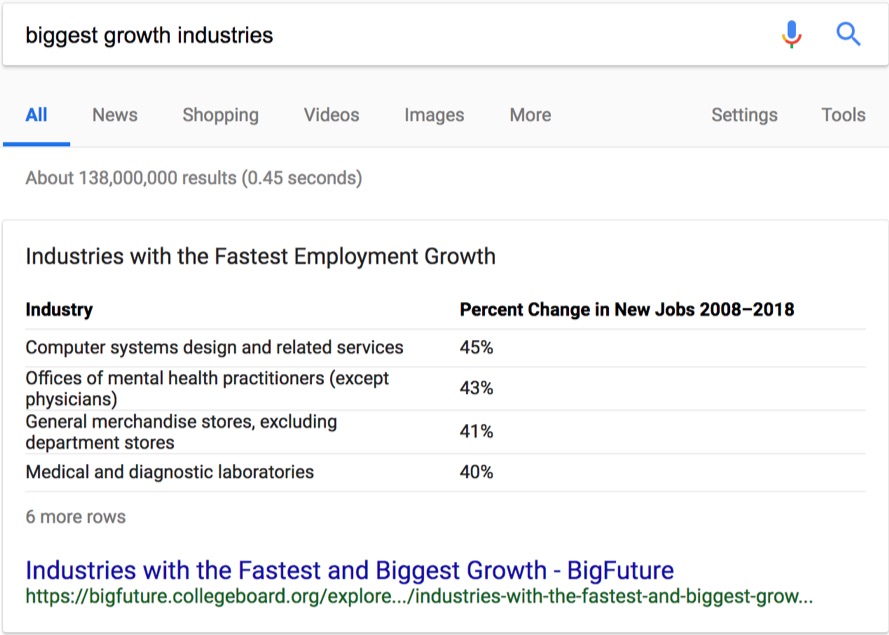
As you can see, the CollegeBoard table is pulled directly to the top of the SERP.
Featured snippets like these now appear in about 30% of Google results.
However, featured snippets can cause some complications when it comes time for Google users to go back to your site.
According to a study from Ahrefs, only about 8.6% of clicks go to the featured snippet.
Compared to 19.6% of clicks to the first natural search result, this is a major difference.

However, those 8.6% of clicks can still drive a massive wave of traffic to your website if you were previously struggling to reach the top of a SERP.
Featured snippets also have the added benefit of making your content competitive for voice searches.
With an estimated one billion voice searches each month, it’s an area you can’t afford to ignore.
When a user performs a voice search, the response played back to them is often a featured snippet.
In fact, Moz did a study to see how many featured snippet searches would deliver a voice response.
Pulling 1,000 searches that contained featured snippet results, they performed voice searches to see if the response matched.
71% of the time, the answer was yes.
However, they then broke down these results based on type.
Text snippets were 87% likely to be featured as a voice response.
List responses appeared about half the time, while tables only came up about a third of the time.
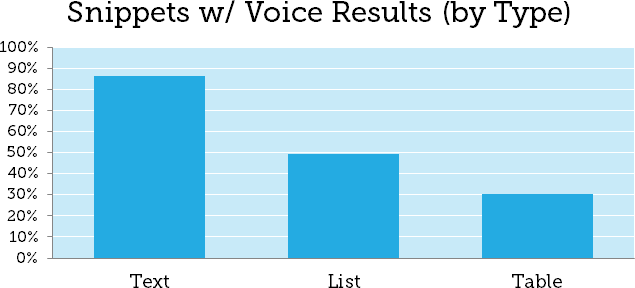
When we think about the nature of voice search, this isn’t too surprising.
While lists and tables make for great visual results on a traditional search engine, the ease of reading a snippet makes text much more practical for voice search.
As more and more individuals purchase voice-powered smart speakers, the need for appropriate responses will only become more important to brands.
However, there is no guarantee that you’ll land a featured snippet slot.
Like all things SEO, getting your content placed in a featured snippet slot takes some planning.
Here are the steps you need to follow to secure a featured snippet slot of your own.
1. Create content that answers a direct question
Featured snippets typically appear as a result of a direct question.
Moz posted a study on featured snippets where they compared results using the following question starters.

They found that most of these questions delivered paragraph featured snippets.
Questions beginning with “does,” “why,” and “are” resulted in paragraph featured snippets about 99.9% of the time.
“How” and “have” questions resulted in list featured snippets while “which” questions were the highest for table featured snippets.
Let’s take a look at the featured snippet that appears when you search “how to tie a tie.”
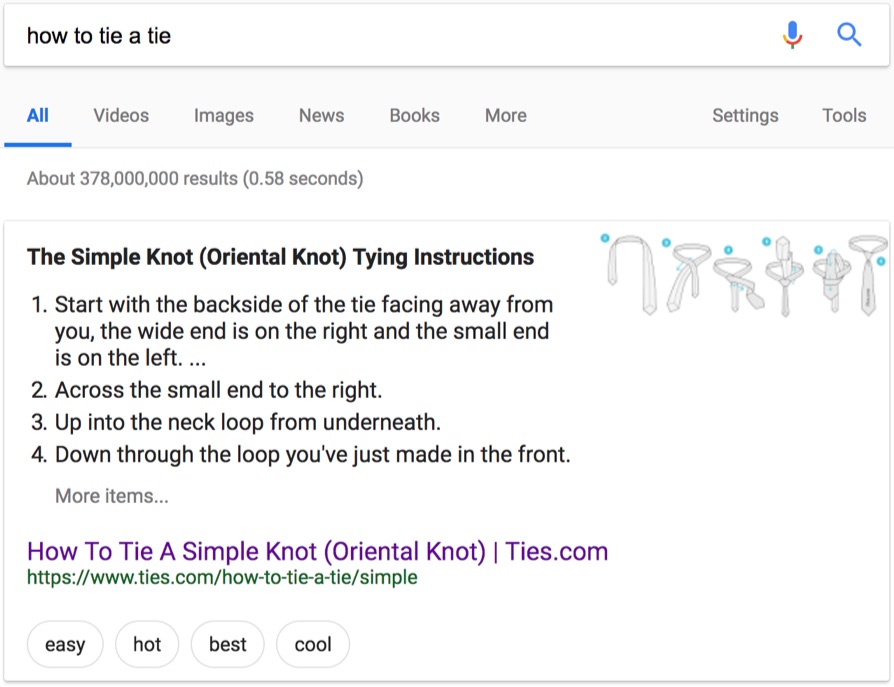
When you type this question into the search bar, you’re given a featured snippet.
However, let’s look what happens when you simply search “tie a tie.”
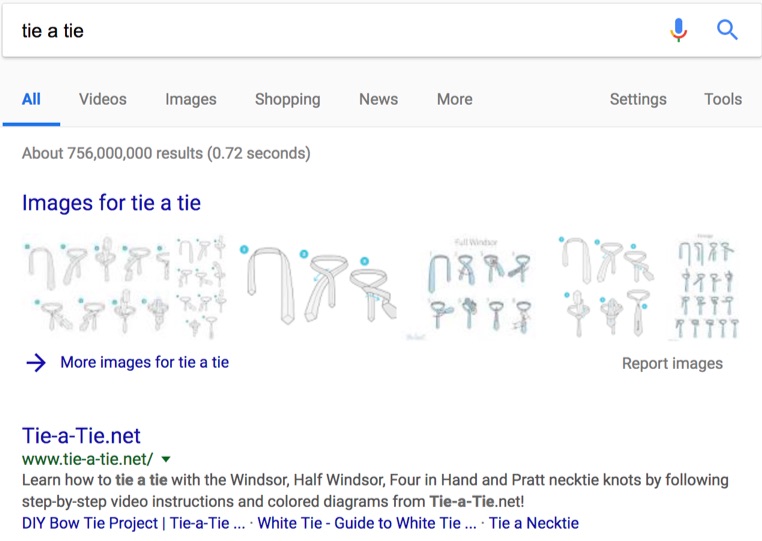
The results are much more basic.
Rather than the featured snippet, you’re given images and traditional results.
Simply targeting keywords associated with questions isn’t enough. To land the featured snippet placement, you need to be sure to include a direct question.
Let’s look at the way some other questions turn up on Google.
Say I want to learn more about who Mark Cuban is. I go to the search engine and just type in “Mark Cuban.”
This is my result.
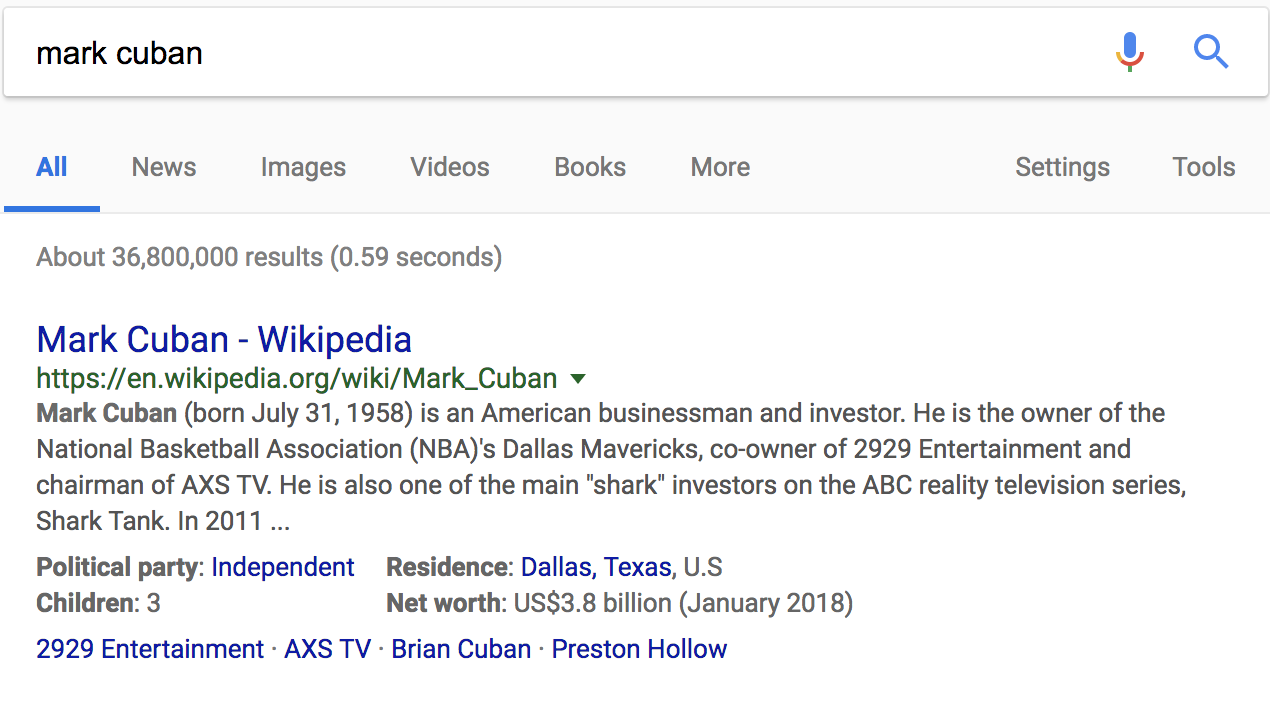
While I’m able to pull some key information from this listing, the snippet isn’t the primary resource.
However, let’s turn my search into a question.
Here is my result for searching “Who is Mark Cuban.”
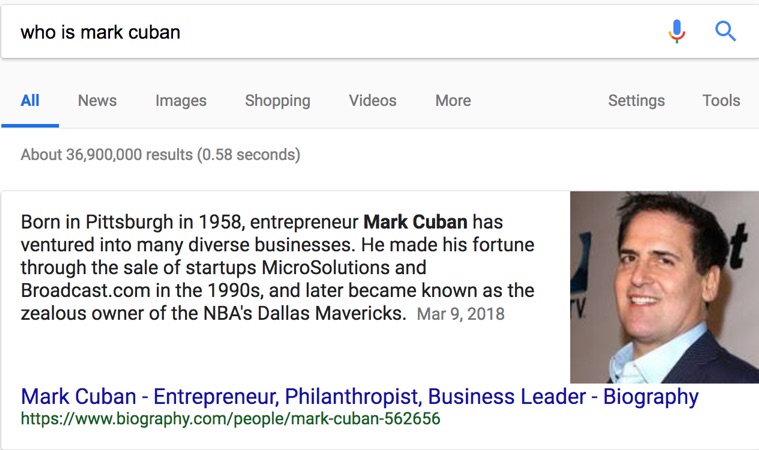
By simply adding the “who is” to my search, we get an entirely new featured snippet.
Again, you’ll notice that the source of the featured snippet is not the same resource from the first search.
To secure the featured snippet placement for yourself, you want to be sure you’re targeting direct questions – not just keywords that may appear within the question.
If you’re trying to secure a list featured snippet, focus on “how to” questions.
Use “which” when trying to target table featured snippets.
Stick to the basics. “Who,” “how,” “why,” “when,” and “where” are all great places to start.
One way to cover a number of questions at once is through an FAQ or Q&A page.
Moz was able to help an orthodontist increase organic sessions to their website by 46.10% by targeting featured snippets through a Q&A.
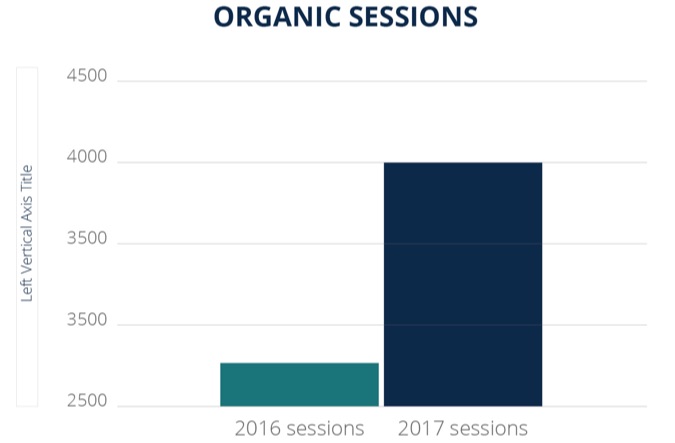
A FAQ or Q&A page can help you cover many questions without overwhelming your visitors.
By providing short, scannable responses to questions you get asked frequently, you can provide high-value content to your target audience while also increasing your chances of getting a featured snippet slot.
However, you want to be strategic about the questions you target.
Which brings us to our next point…
2. Find the ranking opportunities unique to your audience
What is one of the key best practices when doing SEO?
Keyword research.
But what is one of the most important things to consider when doing keyword research?
Your audience.
If the keywords you target aren’t used by your audience, you may turn up in a search, but you’re not going to get any clicks.
Featured snippets work the same way.
Targeting just any slot is a waste of time and resources.
Instead, you want to get your featured snippets placed at the top of searches your audience is already looking for.
You can identify these ranking opportunities in a few different ways.
First, start with keyword research.
To rank for a featured snippet, you need to be among the Top 10 results for that keyword 99.58% of the time.
To identify snippets you may be able to be featured for, consider what keywords you’re already ranking highly for.
Next, think of a basic question that applies to your industry or business.
For this example, let’s use “what is AI.”
Here are our results.

While this doesn’t show a featured snippet, what we do get are some additional questions people are also searching for under “People Also Ask.”
Users can click one of the “People Also Ask” questions and get a short response.

These “People also ask” questions can be a great place to start learning about what your audience is looking for.
There are a few different ways you can find the questions your audience is asking.
One of the best places to look is on Quora.
Quora has 190 million monthly users, all asking questions, providing answers, and engaging in conversations.
Here is what you find when you search “what is AI” in Quora.

In addition to a response, you’re also shown a list of related questions.
Like the “People Also Ask” section from your Google search, these questions can give you an idea of what people want to know.
Another great place to generate potential questions is Answer the Public.
By typing in a keyword, Answer the Public will generate some question responses.
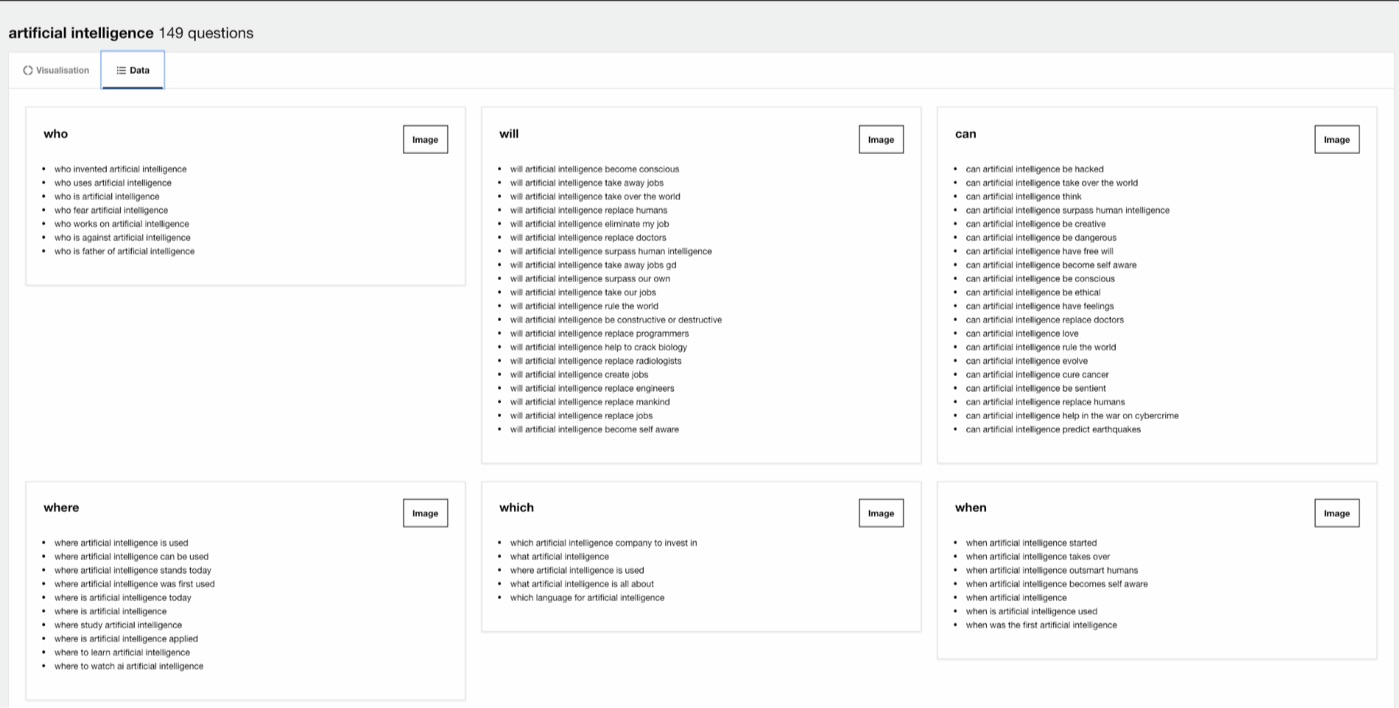
However, these questions are computer-generated without considering important metrics like search volume or popularity.
Based on these suggestions, you’ll want to do additional research to see what questions are actually being asked by your audience.
You can also use the SERPStat tool to pull some additional data about questions.
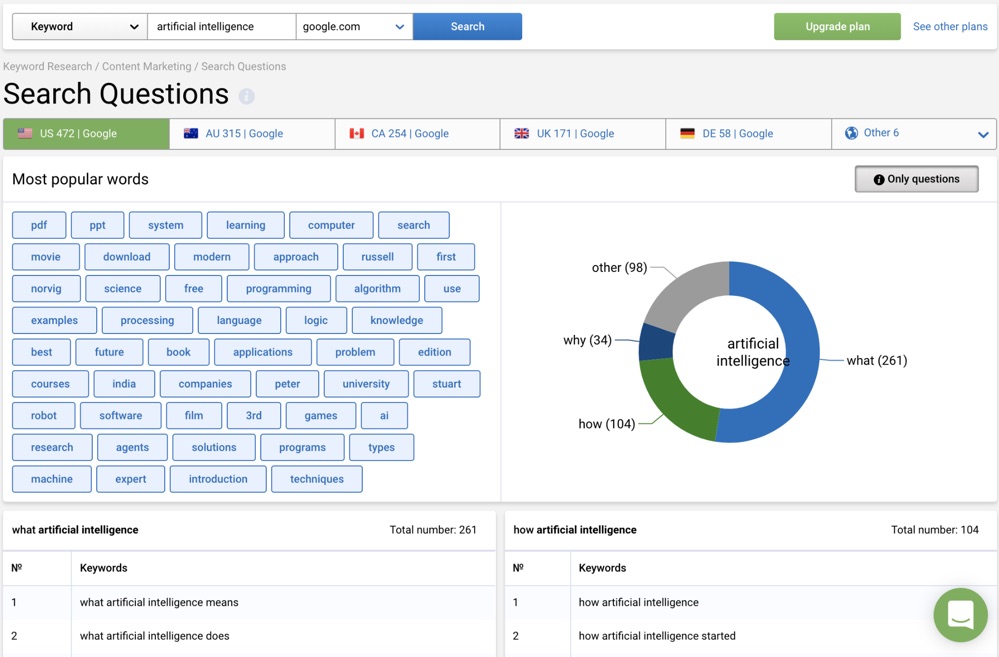
The content marketing section of the tool can break down different search questions associated with the keyword you’ve searched.
This can help you better understand which questions are actually being used and how frequently they’re appearing.
SERPStat also allows you to see which keywords are already displaying featured snippets.
Within the Keyword Selection tool under SEO Research, you can filter results to see only those already featuring snippets.
This can help you hone in even more on the keywords you should target.
Doing the proper research before determining which snippets you’d like to target can increase your chances.
However, you need to remember that you’re trying to connect with your target audience.
Pay close attention to their unique needs or search behavior.
In addition to knowing what keywords and questions are popular with search engines, take a minute to look through social media or other platforms that can give you direct access to your target audience.
The more you learn about your audience, the more likely you are to reach them through a featured snippet.
3. Maintain extremely high-quality content with the right formatting
If you’ve ever done SEO before, you know that keyword placement alone isn’t enough to rank in the top spot.
In fact, there are dozens of on-page, backlink, off-page, and domain factors that are considered in where a piece of content ranks.
On-site factors include everything from domain authority to affiliate links – and this is just the tip of the SEO iceberg.

However, each factor revolves around one thing – user experience.
When Google decides which results should make the top of the list, it looks at which pieces are most likely to help the user.
The same applies to featured snippets.
If you want your snippet to be featured, you need to produce the best response to the question.
As we mentioned in the first point, your response should be in answer form.
You’ll also want to make sure your response is clear, to the point, and your steps are not extremely detailed.
The results for “how to screenshot on a Mac” are a great example of how you can do this.
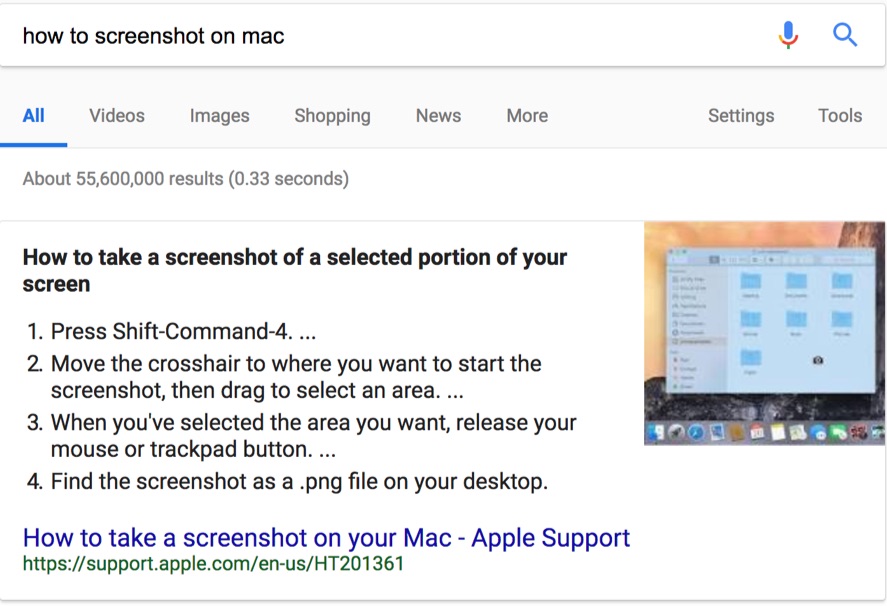
Within this featured snippet, we’re able to see the entire four-step process of how you can take a screenshot on a Mac computer.
Each instruction is direct and concise, allowing the user to get the full amount of information right within the SERP.
You’ll see that some steps have an ellipsis.
This indicates that there is additional information that goes with that step, but it isn’t necessary for the instructions.
Keep this in mind when writing out your instructions. Start each point with a sentence that is capable of standing alone.
When formatting this content on your website, you’ll also want to display it as the featured snippet type you’re trying to target.
Here’s what that same bit of information looks like on the Apple Support website.
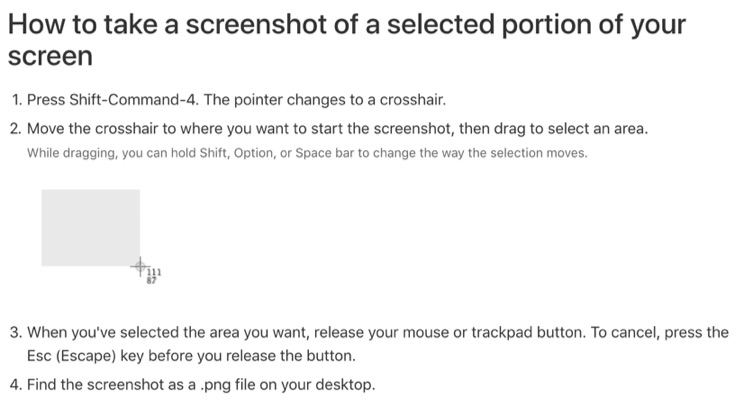
While you’ll see there are some additional bits of information, it’s more or less formatted the same as the snippet.
This is particularly crucial for table snippets.
With paragraph snippets, you don’t need to have particular formatting to get featured.
You do, however, need to use concise writing.
Here is a featured paragraph snippet that appears when you search “who is Elon Musk.”
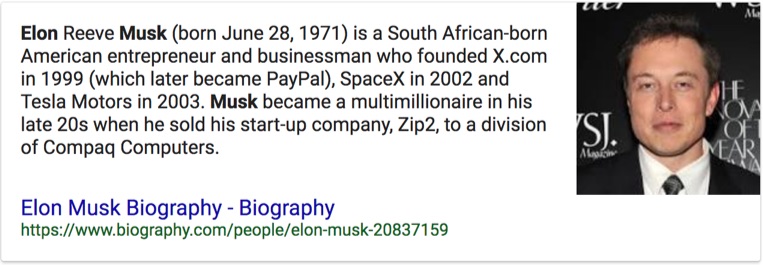
Within this one paragraph, you get his full biography.
If you’re hoping to target paragraph snippets, then try to fit all your information into two or three sentences.
To further increase your chances, use an H2 header containing the question you’re trying to rank for.
Then immediately after, provide a short and concise response that also contains your targeted keyword.
Structured data, sometimes just called Schema markup, can also help you rank for a featured snippet.
However, you don’t need to have structured data to be ranked.
Structured data just helps Google understand what your content is about. The easier it is for Google to see your value, the more likely you are to rank highly.
You can use the Google Structured Data Markup Helper to get started with your markups.
4. Know the other available answers, then do better.
So, you’ve landed the coveted featured snippet position.
You can finally relax, right?
Nope.
Just like traditional SEO, a featured snippet can be snatched away from you before you even get comfortable.
With competitors making their own strategic movements to land that “0 placement,” you always need to be aware of what they’re doing.
Even if Google deems you the most worthy of that slot for a little while, they’ll constantly be searching the web trying to find someone who can answer the question better.
If you’re not paying attention to the responses your competitors are generating, they may surpass you.
However, SEO competitors aren’t necessarily your business competitors.
This is especially true when users are looking for questions.
Here’s an example.
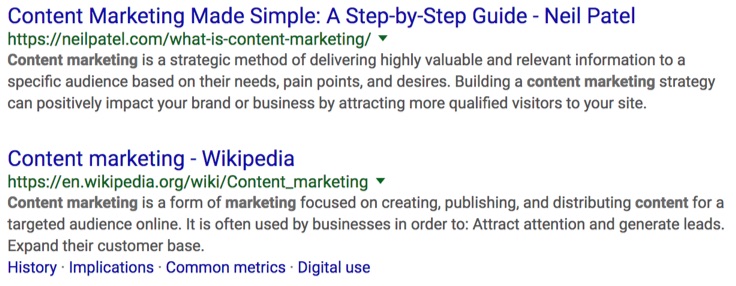
When you search “content marketing,” you can select between two posts – one from my site and one from Wikipedia.
While Wikipedia may not be one of my direct business competitors, when it comes to fighting for SEO rankings, we might as well be enemies.
If you’re only monitoring your direct business competitors, more generic response or information pages may sneak up behind you.
There are a few ways you can identify and track these SEO competitors.
First, let’s go back to Google “People Also Ask” questions.
Here are some related questions when searching “what social media is most popular.”
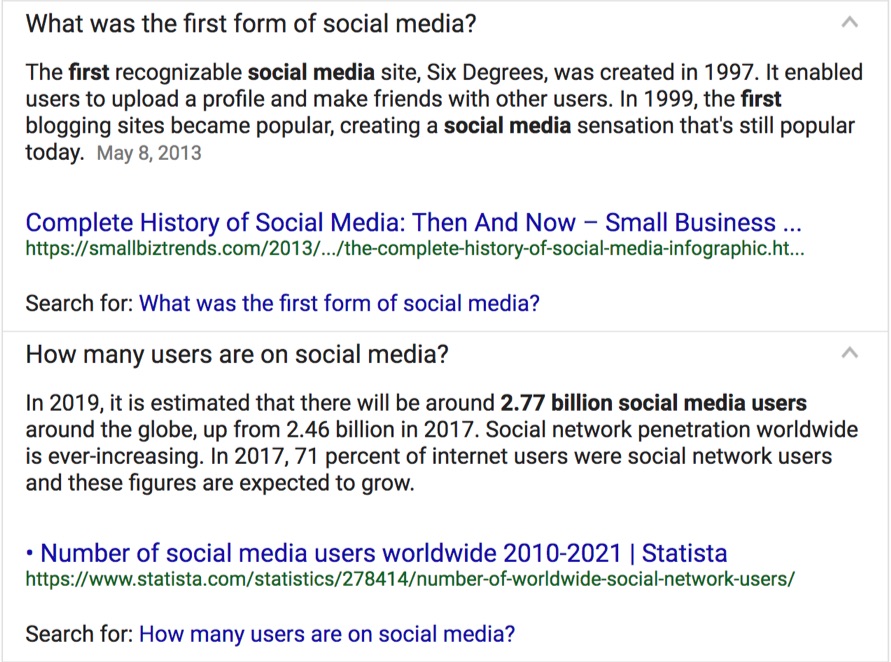
While neither of these responses answers the question of the most popular social media, they’re still responding to the same audience and industry.
Both Small Biz Trends and Statista should be seen as competitors within this space – even if they’re not necessarily your business competitors.
Once you have a list of a few potential competitors, you’ll want to keep your eye on them.
Now, you don’t need to check every blog post they upload.
You don’t need to spend hours trying to scan their social media profiles.
Instead, you can set up alerts so you’ll be notified whenever there is new content on a particular topic.
Google Alerts is your best friend when it comes to tracking specific topics or individuals.
Let’s say you’re Statista wanting to defend your feature for the question “how many users are on social media.”
You might set up a Google Alert that looks a bit like this:
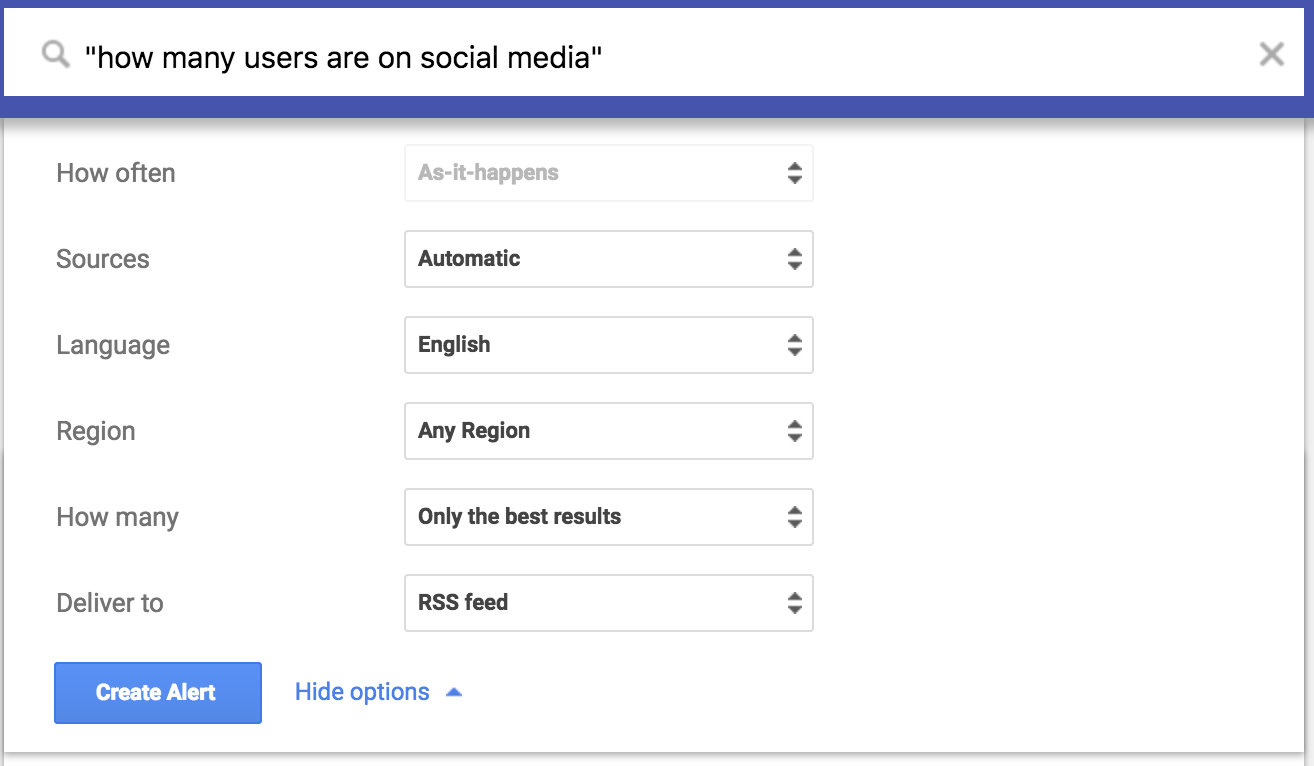
Every time a new post containing the phrase “how many users are on social media” is uploaded, Google will send you a message or deliver the content to an RSS feed.
Here is an example of some of the results you may get.
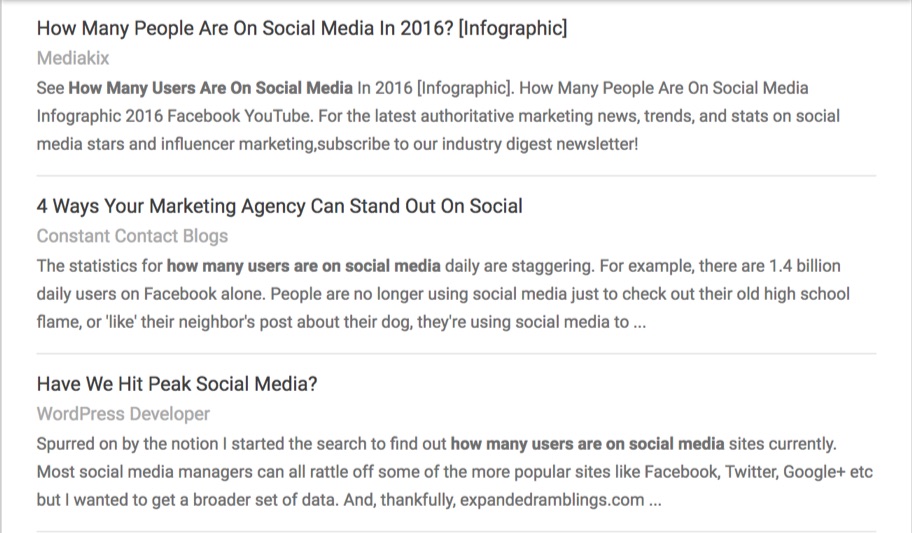
Google Alerts also gives you some options to create an alert that fits your unique needs.
If you’re looking for only results in a specific language, only blog posts, or even only posts coming from a certain region, you can narrow your alerts down.
You’ll want to create a few different alerts around the featured snippet questions you’re targeting.
In this case, you may also want to establish alerts for phrases like “social media users,” “number of Facebook users,” or “how many users on Twitter.”
Conclusion
Slow and steady may win the race when it comes to traditional SEO, but featured snippets are here to shake things up.
As snippets become more and more popular and new forms of featured snippets are rolled out, the competition will only grow.
By appealing to these newer areas of SERPs early on, you can leapfrog your competition – getting you more search engine traffic faster.
How have you used featured snippets to increase awareness or website traffic?
About the Author: Neil Patel is the cofounder of Neil Patel Digital.

one of the biggest metrics Google is measuring is click through rate and it's also one of the easiest to manipulate
from Brian Milners SEO Feed http://feedproxy.google.com/~r/KISSmetrics/~3/3EVIiuOCUrw/
via
IFTTT






























